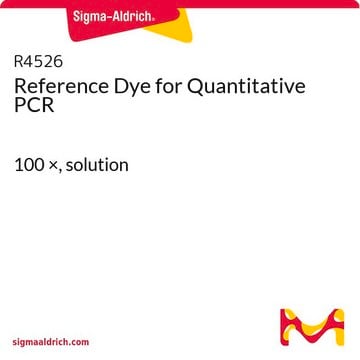S1816
SYBR® Green JumpStart™ Taq ReadyMix™ for Quantitative PCR, Capillary Formulation
SYBR® Green qPCR reagent for Roche LightCycler® capillary systems
About This Item
Produits recommandés
Forme
liquid
Utilisation
sufficient for 100 reactions
sufficient for 400 reactions
Caractéristiques
dNTPs included
hotstart
Concentration
1 units/reaction (20 μL reaction volume)
Technique(s)
qPCR: suitable
Couleur
colorless
Entrée
purified DNA
Compatibilité
for use with Roche LightCycler 480
Méthode de détection
SYBR® Green
Conditions d'expédition
wet ice
Température de stockage
−20°C
Description générale
SYBR Green Taq ReadyMix is recommended for single product real-time amplification experiments and may also be used for evaluation of primer sequences prior to manufacture of fluorescent-labeled probes. Fluorescent labeled probes are not recommended for use with SYBR Green I dye.
Application
Caractéristiques et avantages
- Convenient 2× concentrate ReadyMix specifically designed for use with capillary instruments such as the Roche LightCycler® and is ideal for high throughput applications
- Increased specificity & target yield - JumpStart™ Taq polymerase prevents non-specific product resulting in more accurate CT values and improved quantitation
- This master mix allows consistency from one reaction to the next
- Designed to reduce the preparation time and minimize contamination from multiple pipetting steps
- The double-strand DNA-specific SYBR® Green I fluorescent dye is inexpensive, easy to use, and sensitive and is ideal for quantifying any DNA sequence
Conditionnement
100RXN is packaged as 1 X 1 mL
400RXN is packaged as 1 X 4 mL
Principe
The JumpStart Taq antibody inactivates the DNA polymerase at room temperature. When the temperature is raised above 70 °C in the first denaturation step of the cycling process, the complex dissociates and the polymerase becomes fully active. JumpStart Taq DNA polymerase prevents non-specific amplification resulting in more accurate CT values.
To prepare a reaction, 10 μL of ReadyMix is added to primers, template and water for a final reaction volume of 20 μL.
Définition de l'unité
Informations légales
Produit(s) apparenté(s)
Code de la classe de stockage
10 - Combustible liquids
Classe de danger pour l'eau (WGK)
WGK 1
Point d'éclair (°F)
Not applicable
Point d'éclair (°C)
Not applicable
Certificats d'analyse (COA)
Recherchez un Certificats d'analyse (COA) en saisissant le numéro de lot du produit. Les numéros de lot figurent sur l'étiquette du produit après les mots "Lot" ou "Batch".
Déjà en possession de ce produit ?
Retrouvez la documentation relative aux produits que vous avez récemment achetés dans la Bibliothèque de documents.
Les clients ont également consulté
Articles
qPCR investigates gene expression, amplification, and alterations, crucial for tumor biology and understanding cancer genetics.
Watch these videos to learn how real time or quantitative PCR (qPCR) works and the benefits of both the SYBR Green-based and probe-based methods of qPCR assay.
The polymerase chain reaction is one of the most widely used techniques in molecular biology. The PCR process consists of three main steps, Denaturation, Annealing & Extension
La réaction en chaîne par polymérase (PCR) est l'une des techniques les plus couramment utilisées en biologie moléculaire. Le procédé de PCR implique trois étapes principales : la dénaturation, l'hybridation des amorces et l'élongation
Protocoles
A protocol that can be used as a basic template for qPCR incorporating SYBR Green I DNA binding dye that is amenable to modification and applicable for use as validation for a set of primers.
Our SYBR Green qPCR Protocol is a method designed to detect accurate quantification of gene expression and RT-PCR reactions
Notre protocole de qPCR avec SYBR Green est conçu pour quantifier précisément l'expression génique ou des réactions de RT-PCR.
Contenu apparenté
SYBR® Green I, a commonly used fluorescent DNA binding dye, binds all double-stranded DNA and detection is monitored by measuring the increase in fluorescence throughout the cycle. Explore our LuminoCt® and KiCqStart® products for Fast qPCR or JumpStart™ reagents for conventional qPCR
RT-qPCR detects specific targets with applications in gene expression and pathogen detection.
La RT-qPCR, ou PCR quantitative après transcription inverse, combine les effets de la transcription inverse et de la PCR quantitative, ou PCR en temps réel, pour amplifier et détecter des cibles spécifiques. La RT-qPCR trouve de multiples applications, notamment dans la quantification du niveau d'expression génique, la validation de l'interférence par ARN ou la détection d'agents pathogènes comme les virus.
Notre équipe de scientifiques dispose d'une expérience dans tous les secteurs de la recherche, notamment en sciences de la vie, science des matériaux, synthèse chimique, chromatographie, analyse et dans de nombreux autres domaines..
Contacter notre Service technique












